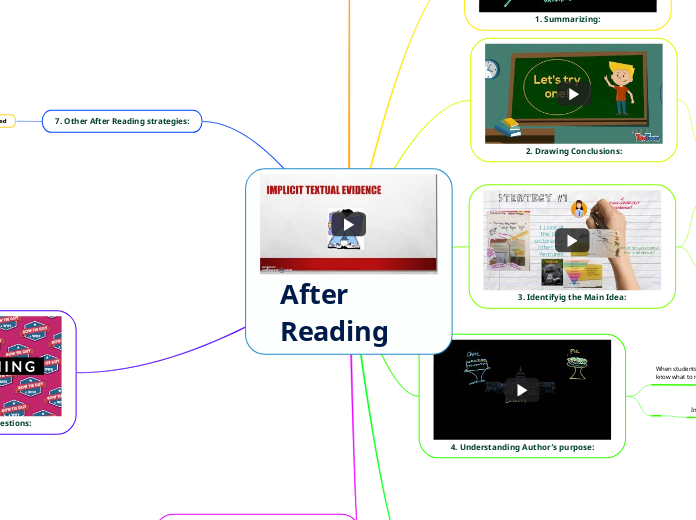After Reading
Purpose: Students are able to analyze and conclude about the reading.
1. Summarizing:
Students reduce the text and include the main idea in their own words.
Naglieri and Pickering
3 steps
1.Show the students how to summarize
2. Allow the students to practice summarize
3. Encourage the independent use of Summarizing
2. Drawing Conclusions:

It helps the reader to understand the text and to get a deeper meaning about what the author wants to express.
3. Identifyig the Main Idea:
With this strategy students will be able to uncover what the author wants us to know about the text.
It can be expressed directly, or it can be implied.
Students can will follow some clues to find the main idea.
They can use questions words to help them to find
The main idea:
1. What
2. Who
3. When
4. Where
5. Why
6. How
4. Understanding Author’s purpose:
When students know why an author wrote a text help the to know what to remember.
Important reasons for an author to write something:
Persuade: The author shares their opinion with the reader
Inform: The author presents facts to the reader
Entertain: The author amuses the reader.
Teach: The authors try to make the reader to learn something.
References
Starke K. (2015) Post-Reading Comprehension Strategies
Recovered from: https://www.teachhub.com/teaching-strategies/2015/11/post-reading-teaching-strategies/
Rochester Institute of Technology. (2022) After Reading: Tasks and Strategies
Recovered from: https://www.rit.edu/ntid/sea/processes/comprehension/process/after
Oldenburg D. (2022) POST-READING STRATEGIES
Recovered from: https://dustinoldenburg.weebly.com/post-reading-strategies.html
7. Other After Reading strategies:
Janelle Cox proposed
1. Exit Slips
Students can easily think about what they have just learned.
it reinforces criticall thinking.
2. Frame Routine
Students need to use a graphic organizer to brainstorm the text ideas.
3. Question the Author
students consolidate the reading process and they feel secure to critique the authors writing.
6. Comprehension Questions:
QAR (Question-Answer-Relationships)
It teaches students how to ask questions about their reading and where to find the answers.
It helps readers to think about the text they are reading and beyond it, too.
It inspires the reader to think creatively and work cooperatively while challenging them to use higher-level thinking skills.
Raphael and Au (2005 pp 206-221)
Types of questions
1. Right There Questions
2. Think and Search Questions
3. Author and You
4. On My Own
Subtopic
5. Confirming predictions:
Students will find information through the reading
that can confirm if the predictions they made before are
real or not.
The reader can make another predictions with the new information.
